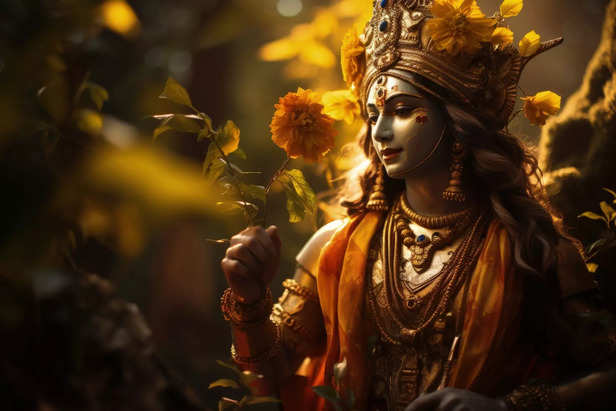The Bhagavad Gita’s View on Life and Death
Rishit raj | Mar 22, 2025, 18:31 IST
Bhagavad gita image
The Bhagavad Gita provides deep insights into life and death, teaching that the soul is eternal and merely transitions from one body to another. This article explores how the Gita explains the impermanence of the physical world, the law of karma, and the cycle of rebirth. It also delves into how Krishna’s wisdom can help us overcome fear, attachment, and grief, ultimately leading to a life of peace and fulfillment.
The Bhagavad Gita, one of the most revered Hindu scriptures, presents a profound philosophy on life and death. Spoken by Lord Krishna to Arjuna on the battlefield of Kurukshetra, the Gita teaches that death is not an end but a mere transition. By understanding its wisdom, one can overcome the fear of mortality and embrace life with clarity and purpose.

A central teaching of the Bhagavad Gita is that the soul (Atman) is eternal and indestructible. In Chapter 2, Verse 20, Krishna explains:
"For the soul, there is neither birth nor death at any time. It has not come into being, does not come into being, and will not come into being. It is unborn, eternal, ever-existing, and primeval. It is not slain when the body is slain."
This verse clarifies that while the physical body perishes, the soul transcends birth and death, continuing its journey through different lives.

In Chapter 2, Verse 22, Krishna likens death to changing clothes:
"As a person sheds worn-out garments and wears new ones, likewise the soul discards its worn-out body and enters a new one."
This perspective shifts our understanding of death from being an absolute end to a natural process of transformation, reinforcing the idea that we should not fear it.

The Bhagavad Gita emphasizes that actions (karma) determine our future lives. Our deeds in the present life shape the circumstances of our rebirth. This aligns with the doctrine of karma and samsara (cycle of birth and death).
Krishna reassures Arjuna that those who live a righteous life attain higher spiritual realms, while those bound by selfish desires continue the cycle of rebirth until they achieve liberation (moksha).

One of the most powerful messages of the Gita is to cultivate detachment. Krishna advises Arjuna to perform his duty without attachment to the results. This mindset helps in overcoming the sorrow associated with death.
In Chapter 2, Verse 27, Krishna states:
"For one who has taken birth, death is certain; and for one who has died, birth is certain. Therefore, you should not lament over the inevitable."
By accepting death as a natural part of existence, one can lead a fearless and purposeful life.
The ultimate goal in the Bhagavad Gita is to transcend the cycle of birth and death. Krishna teaches that by surrendering to Him, practicing selfless devotion (bhakti), and attaining spiritual wisdom (jnana), one can achieve moksha, the state of eternal bliss and union with the Divine.
The Bhagavad Gita’s perspective on life and death is deeply transformative. It teaches that death is not to be feared but understood as a natural transition. By recognizing the immortality of the soul, embracing karma, and practicing detachment, one can overcome fear and live with peace and purpose. Through devotion and self-realization, one can ultimately break free from the cycle of rebirth and attain eternal liberation.
The Eternal Nature of the Soul (Atman)

photorealistic-representation-deity-krishna
( Image credit : Freepik )
A central teaching of the Bhagavad Gita is that the soul (Atman) is eternal and indestructible. In Chapter 2, Verse 20, Krishna explains:
"For the soul, there is neither birth nor death at any time. It has not come into being, does not come into being, and will not come into being. It is unborn, eternal, ever-existing, and primeval. It is not slain when the body is slain."
This verse clarifies that while the physical body perishes, the soul transcends birth and death, continuing its journey through different lives.
Death as a Mere Transition

photorealistic-representation-krishna-deity (1)
( Image credit : Freepik )
In Chapter 2, Verse 22, Krishna likens death to changing clothes:
"As a person sheds worn-out garments and wears new ones, likewise the soul discards its worn-out body and enters a new one."
This perspective shifts our understanding of death from being an absolute end to a natural process of transformation, reinforcing the idea that we should not fear it.
The Law of Karma and Rebirth

photorealistic-representation-deity-krishna (1)
( Image credit : Freepik )
The Bhagavad Gita emphasizes that actions (karma) determine our future lives. Our deeds in the present life shape the circumstances of our rebirth. This aligns with the doctrine of karma and samsara (cycle of birth and death).
Krishna reassures Arjuna that those who live a righteous life attain higher spiritual realms, while those bound by selfish desires continue the cycle of rebirth until they achieve liberation (moksha).
Detachment and Acceptance of Death

photorealistic-representation-krishna-deity
( Image credit : Freepik )
One of the most powerful messages of the Gita is to cultivate detachment. Krishna advises Arjuna to perform his duty without attachment to the results. This mindset helps in overcoming the sorrow associated with death.
In Chapter 2, Verse 27, Krishna states:
"For one who has taken birth, death is certain; and for one who has died, birth is certain. Therefore, you should not lament over the inevitable."
By accepting death as a natural part of existence, one can lead a fearless and purposeful life.
